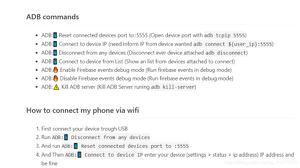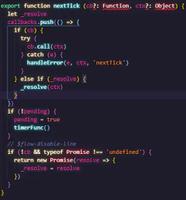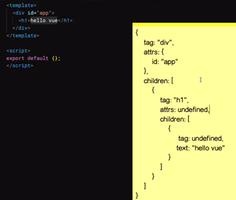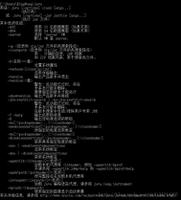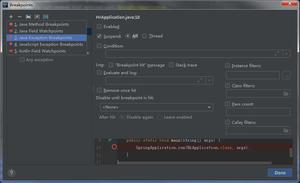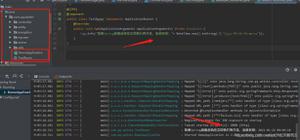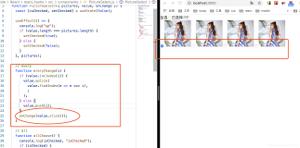React源码 ReactDOM.render

在 react 当中,主要创建更新的有三种方式
1、ReactDOM.render || hydrate
这两个api都是要把这个应用第一次渲染到我们页面上面,展现出来整个应用的样子的过程,这就是初始渲染
2、setState
3、forceUpdate
ReactDOM.render 需要做哪些事情呢?
1、创建 ReactRoot
2、创建 FiberRoot 和 RootFiber
3、创建更新
import React, { Component } from 'react'import './App.css'
class List extends Component {
state = {
a: 1,
b: 2,
c: 3,
}
handleClick = () => {
this.setState(oldState => {
const { a, b, c } = oldState
return {
a: a * a,
b: b * b,
c: c * c,
}
})
}
render() {
const { a, b, c } = this.state
return [
<span key="a">{a}</span>,
<span key="b">{b}</span>,
<span key="c">{c}</span>,
<button key="button" onClick={this.handleClick}>
click me
</button>,
]
}
}
class Input extends Component {
state = {
name: 'jokcy',
}
handleChange = e => {
// 这里如果使用方法设置`state`
// 那么需要现在外面读取`e.target.value`
// 因为在React走完整个事件之后会重置event对象
// 以复用event对象,如果等到方法被调用的时候再读取`e.target.value`
// 那时`e.target`是`null`
this.setState({
name: e.target.value,
})
}
render() {
return (
<input
type="text"
style={{ color: 'red' }}
onChange={this.handleChange}
value={this.state.name}
/>
)
}
}
class App extends Component {
render() {
return (
<div className="main">
<Input />
<List />
</div>
)
}
}
export default App
这个 demo 非常简单,一个 Input 一个 List ,Input 里面有个 state ,属性有 name,然后 render 里面有个 input 标签,这个标签,输入的时候去改变这个 name 。
第二个组件是 List ,这个 List 里面有三个 span ,三个 span 里面分别显示 state 的属性 a,b,c ,然后点击 click ,a,b,c 以乘以自己的方式改变值。这就是这个 demo 的样子。 然后我们看一下最终要渲染这个应用,会调用 ReactDOM.render ,然后传入这个 App ,第二个是这个应用会挂载到的节点上
import React from 'react'import ReactDOM from 'react-dom'
import './index.css'
import App from './App';
ReactDOM.render(<App />, document.getElementById('root'))
我们这里传入的是 <App /> ,实际上我们传入的是 React.createElement。我们传进去的是 App 这个类,但是并没有创建这个实例,这个时候还什么东西都没有,因为我们只得到了一个 createElement,最终要形成一个页面渲染出来的过程,这就是 ReactDOM.render 要做的事情,然后看下这个源码,打开 ReactDOM.js。 react-dom 下面有不同的包,有 client , 有 server . 还有 shared , shared 是在 cilent 和 server 里面都会用到的。对应的就是渲染的平台不一样,server 就是在 Nodejs 下面进行渲染的一个工具包,我们主要了解的是 client 下面的东西。在 ReactDOM.js 下面,我们先找到定义 ReactDOM 的地方
const ReactDOM: Object = { createPortal,
findDOMNode(
componentOrElement: Element | ?React$Component<any, any>,
): null | Element | Text {
if (__DEV__) {
let owner = (ReactCurrentOwner.current: any);
if (owner !== null && owner.stateNode !== null) {
const warnedAboutRefsInRender =
owner.stateNode._warnedAboutRefsInRender;
warningWithoutStack(
warnedAboutRefsInRender,
'%s is accessing findDOMNode inside its render(). ' +
'render() should be a pure function of props and state. It should ' +
'never access something that requires stale data from the previous ' +
'render, such as refs. Move this logic to componentDidMount and ' +
'componentDidUpdate instead.',
getComponentName(owner.type) || 'A component',
);
owner.stateNode._warnedAboutRefsInRender = true;
}
}
if (componentOrElement == null) {
return null;
}
if ((componentOrElement: any).nodeType === ELEMENT_NODE) {
return (componentOrElement: any);
}
if (__DEV__) {
return DOMRenderer.findHostInstanceWithWarning(
componentOrElement,
'findDOMNode',
);
}
return DOMRenderer.findHostInstance(componentOrElement);
},
hydrate(element: React$Node, container: DOMContainer, callback: ?Function) {
// TODO: throw or warn if we couldn't hydrate?
return legacyRenderSubtreeIntoContainer(
null,
element,
container,
true,
callback,
);
},
render(
element: React$Element<any>,
container: DOMContainer,
callback: ?Function,
) {
return legacyRenderSubtreeIntoContainer(
null,
element,
container,
false,
callback,
);
},
unstable_renderSubtreeIntoContainer(
parentComponent: React$Component<any, any>,
element: React$Element<any>,
containerNode: DOMContainer,
callback: ?Function,
) {
invariant(
parentComponent != null && ReactInstanceMap.has(parentComponent),
'parentComponent must be a valid React Component',
);
return legacyRenderSubtreeIntoContainer(
parentComponent,
element,
containerNode,
false,
callback,
);
},
unmountComponentAtNode(container: DOMContainer) {
invariant(
isValidContainer(container),
'unmountComponentAtNode(...): Target container is not a DOM element.',
);
if (container._reactRootContainer) {
if (__DEV__) {
const rootEl = getReactRootElementInContainer(container);
const renderedByDifferentReact =
rootEl && !ReactDOMComponentTree.getInstanceFromNode(rootEl);
warningWithoutStack(
!renderedByDifferentReact,
"unmountComponentAtNode(): The node you're attempting to unmount " +
'was rendered by another copy of React.',
);
}
// Unmount should not be batched.
DOMRenderer.unbatchedUpdates(() => {
legacyRenderSubtreeIntoContainer(null, null, container, false, () => {
container._reactRootContainer = null;
});
});
// If you call unmountComponentAtNode twice in quick succession, you'll
// get `true` twice. That's probably fine?
return true;
} else {
if (__DEV__) {
const rootEl = getReactRootElementInContainer(container);
const hasNonRootReactChild = !!(
rootEl && ReactDOMComponentTree.getInstanceFromNode(rootEl)
);
// Check if the container itself is a React root node.
const isContainerReactRoot =
container.nodeType === ELEMENT_NODE &&
isValidContainer(container.parentNode) &&
!!container.parentNode._reactRootContainer;
warningWithoutStack(
!hasNonRootReactChild,
"unmountComponentAtNode(): The node you're attempting to unmount " +
'was rendered by React and is not a top-level container. %s',
isContainerReactRoot
? 'You may have accidentally passed in a React root node instead ' +
'of its container.'
: 'Instead, have the parent component update its state and ' +
'rerender in order to remove this component.',
);
}
return false;
}
},
// Temporary alias since we already shipped React 16 RC with it.
// TODO: remove in React 17.
unstable_createPortal(...args) {
if (!didWarnAboutUnstableCreatePortal) {
didWarnAboutUnstableCreatePortal = true;
lowPriorityWarning(
false,
'The ReactDOM.unstable_createPortal() alias has been deprecated, ' +
'and will be removed in React 17+. Update your code to use ' +
'ReactDOM.createPortal() instead. It has the exact same API, ' +
'but without the "unstable_" prefix.',
);
}
return createPortal(...args);
},
unstable_batchedUpdates: DOMRenderer.batchedUpdates,
unstable_interactiveUpdates: DOMRenderer.interactiveUpdates,
flushSync: DOMRenderer.flushSync,
unstable_flushControlled: DOMRenderer.flushControlled,
__SECRET_INTERNALS_DO_NOT_USE_OR_YOU_WILL_BE_FIRED: {
// Keep in sync with ReactDOMUnstableNativeDependencies.js
// and ReactTestUtils.js. This is an array for better minification.
Events: [
ReactDOMComponentTree.getInstanceFromNode,
ReactDOMComponentTree.getNodeFromInstance,
ReactDOMComponentTree.getFiberCurrentPropsFromNode,
EventPluginHub.injection.injectEventPluginsByName,
EventPluginRegistry.eventNameDispatchConfigs,
EventPropagators.accumulateTwoPhaseDispatches,
EventPropagators.accumulateDirectDispatches,
ReactControlledComponent.enqueueStateRestore,
ReactControlledComponent.restoreStateIfNeeded,
ReactDOMEventListener.dispatchEvent,
EventPluginHub.runEventsInBatch,
],
},
};
这段就是定义 ReactDOM 的地方。ReactDOM 是个对象,这个对象里面有 render 方法。这个 render 方法我们可以看到他接收的有三个参数。一个是 element ,就是 react element . 第二个是 container ,就是我们要挂载到哪一个节点上面。第三个是 callback ,callback 就是说这个应用渲染结束之后,他会调用这个 callback 。
然后里面直接调用了一个方法叫 legacyRenderSubtreeIntoContainer,然后传入了 null ,element,container,false,callback 这几个参数。
function legacyRenderSubtreeIntoContainer(parentComponent: ?React$Component<any, any>,
children: ReactNodeList,
container: DOMContainer,
forceHydrate: boolean,
callback: ?Function,
) {
// TODO: Ensure all entry points contain this check
invariant(
isValidContainer(container),
'Target container is not a DOM element.',
);
if (__DEV__) {
topLevelUpdateWarnings(container);
}
// TODO: Without `any` type, Flow says "Property cannot be accessed on any
// member of intersection type." Whyyyyyy.
let root: Root = (container._reactRootContainer: any);
if (!root) {
// Initial mount
root = container._reactRootContainer = legacyCreateRootFromDOMContainer(
container,
forceHydrate,
);
if (typeof callback === 'function') {
const originalCallback = callback;
callback = function() {
const instance = DOMRenderer.getPublicRootInstance(root._internalRoot);
originalCallback.call(instance);
};
}
// Initial mount should not be batched.
DOMRenderer.unbatchedUpdates(() => {
if (parentComponent != null) {
root.legacy_renderSubtreeIntoContainer(
parentComponent,
children,
callback,
);
} else {
root.render(children, callback);
}
});
} else {
if (typeof callback === 'function') {
const originalCallback = callback;
callback = function() {
const instance = DOMRenderer.getPublicRootInstance(root._internalRoot);
originalCallback.call(instance);
};
}
// Update
if (parentComponent != null) {
root.legacy_renderSubtreeIntoContainer(
parentComponent,
children,
callback,
);
} else {
root.render(children, callback);
}
}
return DOMRenderer.getPublicRootInstance(root._internalRoot);
}
这个就是 legacyRenderSubtreeIntoContainer 这个方法,第一个参数 null ,他对应的是 parentComponent 这个参数
let root: Root = (container._reactRootContainer: any);
然后下面他获取了 root 这么一个变量,他通过 container , container 就是 DOMContainer ,就是 ReactDOM.render 里面的第二个参数,就是挂载的节点,它上面有没有 _reactRootContainer 这个属性,第一次渲染的时候,这个属性值肯定是没有的,接下来没有的话,他就会去创建这个属性值,通过调用 legacyCreateRootFromDOMContainer 这个方法
function legacyCreateRootFromDOMContainer(container: DOMContainer,
forceHydrate: boolean,
): Root {
const shouldHydrate =
forceHydrate || shouldHydrateDueToLegacyHeuristic(container);
// First clear any existing content.
if (!shouldHydrate) {
let warned = false;
let rootSibling;
while ((rootSibling = container.lastChild)) {
if (__DEV__) {
if (
!warned &&
rootSibling.nodeType === ELEMENT_NODE &&
(rootSibling: any).hasAttribute(ROOT_ATTRIBUTE_NAME)
) {
warned = true;
warningWithoutStack(
false,
'render(): Target node has markup rendered by React, but there ' +
'are unrelated nodes as well. This is most commonly caused by ' +
'white-space inserted around server-rendered markup.',
);
}
}
container.removeChild(rootSibling);
}
}
if (__DEV__) {
if (shouldHydrate && !forceHydrate && !warnedAboutHydrateAPI) {
warnedAboutHydrateAPI = true;
lowPriorityWarning(
false,
'render(): Calling ReactDOM.render() to hydrate server-rendered markup ' +
'will stop working in React v17. Replace the ReactDOM.render() call ' +
'with ReactDOM.hydrate() if you want React to attach to the server HTML.',
);
}
}
// Legacy roots are not async by default.
const isConcurrent = false;
return new ReactRoot(container, isConcurrent, shouldHydrate);
}
我们看到这个方法,他接收两个参数,第一个是 DOMContainer , 第二个是 forceHydrate ,这个 forceHydrate 就是传入的第四个参数,也就是 render 方法里面的第四个参数,是 false , render 方法里面是写死的,是不是代表着永远都是 false 呢,这个主要对应的是另外一种情况,就是 hydrate 这个方法,hydrate 跟 render 本质是一样的,唯一的一个区别就是是否会调和 container 里面的 html 节点,是否要复用这些节点。主要是有服务端渲染的时候会使用 hydrate 这个 api。因为服务端渲染 和 客户端渲染 第一次得到的节点是一样的。这个时候如果可以复用这些节点,可以提高一定的性能。所以他两唯一的区别就是第四个参数是 true 还是 false 。
我们再回到 legacyCreateRootFromDOMContainer ,对于 render 来说,这个 forceHydrate 是 false。那么如果是 false 的情况,会去调用这个方法 shouldHydrateDueToLegacyHeuristic。
function shouldHydrateDueToLegacyHeuristic(container) { const rootElement = getReactRootElementInContainer(container);
return !!(
rootElement &&
rootElement.nodeType === ELEMENT_NODE &&
rootElement.hasAttribute(ROOT_ATTRIBUTE_NAME)
);
}
这个方法里面 return 的是 rootElement 。rootElement 是通过调用 getReactRootElementInContainer 得到的
function getReactRootElementInContainer(container: any) { if (!container) {
return null;
}
if (container.nodeType === DOCUMENT_NODE) {
return container.documentElement;
} else {
return container.firstChild;
}
}
这个方法先判断一下这个 container 是否存在,如果不存在, return,如果存在,再继续判断这个节点是否等于 DOCUMENT_NODE ,就是 document ,就是 window.document ,是否是等于的。如果是等于,就直接返回这个 document 。 如果不是等于,就返回这个 container 的子节点。再回到 shouldHydrateDueToLegacyHeuristic ,判断完他是否是个节点,而且是 ROOT_ATTRIBUTE_NAME,然后返回,这个不是特点重要,跟 react 整体更新没有多大关系,再回到 legacyCreateRootFromDOMContainer 。当这个节点是 false 的情况下,执行了一个 for 循环,这个 for 循环是干嘛的呢?就是把 container 传进来的所有子节点都删掉,因为我们认为 shouldHydrate 为 false 的情况下,在渲染出来后,这些子节点已经不能用了,因为不需要合并他。最后return 一个 new ReactRoot。他传进去的是 container, isConcurrent, shouldHydrate 。 isConcurrent 我们看到直接是 false,已经注明了 root 节点不应该是 async 的。接下来我们看一下 new 一个 root 的过程
function ReactRoot(container: Container,
isConcurrent: boolean,
hydrate: boolean,
) {
const root = DOMRenderer.createContainer(container, isConcurrent, hydrate);
this._internalRoot = root;
}
ReactRoot.prototype.render = function(
children: ReactNodeList,
callback: ?() => mixed,
): Work {
const root = this._internalRoot;
const work = new ReactWork();
callback = callback === undefined ? null : callback;
if (__DEV__) {
warnOnInvalidCallback(callback, 'render');
}
if (callback !== null) {
work.then(callback);
}
DOMRenderer.updateContainer(children, root, null, work._onCommit);
return work;
};
ReactRoot.prototype.unmount = function(callback: ?() => mixed): Work {
const root = this._internalRoot;
const work = new ReactWork();
callback = callback === undefined ? null : callback;
if (__DEV__) {
warnOnInvalidCallback(callback, 'render');
}
if (callback !== null) {
work.then(callback);
}
DOMRenderer.updateContainer(null, root, null, work._onCommit);
return work;
};
ReactRoot.prototype.legacy_renderSubtreeIntoContainer = function(
parentComponent: ?React$Component<any, any>,
children: ReactNodeList,
callback: ?() => mixed,
): Work {
const root = this._internalRoot;
const work = new ReactWork();
callback = callback === undefined ? null : callback;
if (__DEV__) {
warnOnInvalidCallback(callback, 'render');
}
if (callback !== null) {
work.then(callback);
}
DOMRenderer.updateContainer(children, root, parentComponent, work._onCommit);
return work;
};
ReactRoot.prototype.createBatch = function(): Batch {
const batch = new ReactBatch(this);
const expirationTime = batch._expirationTime;
const internalRoot = this._internalRoot;
const firstBatch = internalRoot.firstBatch;
if (firstBatch === null) {
internalRoot.firstBatch = batch;
batch._next = null;
} else {
// Insert sorted by expiration time then insertion order
let insertAfter = null;
let insertBefore = firstBatch;
while (
insertBefore !== null &&
insertBefore._expirationTime <= expirationTime
) {
insertAfter = insertBefore;
insertBefore = insertBefore._next;
}
batch._next = insertBefore;
if (insertAfter !== null) {
insertAfter._next = batch;
}
}
return batch;
};
ReactRoot 方法里面通过 DOMRenderer.createContainer(container, isConcurrent, hydrate) 创建了 root 节点。那么 DOMRenderer 是什么东西呢?
import * as DOMRenderer from 'react-reconciler/inline.dom';
DOMRenderer 其实就是 react-reconciler 下面的 inline.dom 。 inline.dom 里面只引用了 ReactFiberReconciler.js 。打开这个js 之后,找到 createContainer。
export function createContainer(containerInfo: Container,
isConcurrent: boolean,
hydrate: boolean,
): OpaqueRoot {
return createFiberRoot(containerInfo, isConcurrent, hydrate);
}
发现这个方法里面创建了一个 createFiberRoot 。返回到 ReactRoot ,创建完之赋值给 this._internalRoot。然后再赋值给了 container._reactRootContainer ,最后,调用到了 root.render,就是原型链上的 render 方法。这里创建了一个 reactWork,这个不是特别重要,就跳过了。最终调用了 DOMRenderer.updateContainer。
export function updateContainer(element: ReactNodeList,
container: OpaqueRoot,
parentComponent: ?React$Component<any, any>,
callback: ?Function,
): ExpirationTime {
const current = container.current;
const currentTime = requestCurrentTime();
const expirationTime = computeExpirationForFiber(currentTime, current);
return updateContainerAtExpirationTime(
element,
container,
parentComponent,
expirationTime,
callback,
);
}
updateContainer 他接收了 element,container,parentComponent。这个方法里面有三个变量。一个 current, 一个 currentTime。一个 expirationTime 。 expirationTime 是通过computeExpirationForFiber 获得的, expirationTime是非常重要的。然后调用 updateContainerAtExpirationTime 。
export function updateContainerAtExpirationTime(element: ReactNodeList,
container: OpaqueRoot,
parentComponent: ?React$Component<any, any>,
expirationTime: ExpirationTime,
callback: ?Function,
) {
// TODO: If this is a nested container, this won't be the root.
const current = container.current;
if (__DEV__) {
if (ReactFiberInstrumentation.debugTool) {
if (current.alternate === null) {
ReactFiberInstrumentation.debugTool.onMountContainer(container);
} else if (element === null) {
ReactFiberInstrumentation.debugTool.onUnmountContainer(container);
} else {
ReactFiberInstrumentation.debugTool.onUpdateContainer(container);
}
}
}
const context = getContextForSubtree(parentComponent);
if (container.context === null) {
container.context = context;
} else {
container.pendingContext = context;
}
return scheduleRootUpdate(current, element, expirationTime, callback);
}
这里的 context 是没有的,最后调用了 scheduleRootUpdate。
function scheduleRootUpdate(current: Fiber,
element: ReactNodeList,
expirationTime: ExpirationTime,
callback: ?Function,
) {
if (__DEV__) {
if (
ReactCurrentFiber.phase === 'render' &&
ReactCurrentFiber.current !== null &&
!didWarnAboutNestedUpdates
) {
didWarnAboutNestedUpdates = true;
warningWithoutStack(
false,
'Render methods should be a pure function of props and state; ' +
'triggering nested component updates from render is not allowed. ' +
'If necessary, trigger nested updates in componentDidUpdate.\n\n' +
'Check the render method of %s.',
getComponentName(ReactCurrentFiber.current.type) || 'Unknown',
);
}
}
const update = createUpdate(expirationTime);
// Caution: React DevTools currently depends on this property
// being called "element".
update.payload = {element};
callback = callback === undefined ? null : callback;
if (callback !== null) {
warningWithoutStack(
typeof callback === 'function',
'render(...): Expected the last optional `callback` argument to be a ' +
'function. Instead received: %s.',
callback,
);
update.callback = callback;
}
enqueueUpdate(current, update);
scheduleWork(current, expirationTime);
return expirationTime;
}
这里面创建了 createUpdate。update 是用来标记,react 中需要标记更新的地点的,这个方法就是设置了一些update 相关的属性。最后调用 enqueueUpdate 。后面调用了 scheduleWork ,调度,为什么有调度呢,因为有任务优先级的概念。
以上是 React源码 ReactDOM.render 的全部内容, 来源链接: utcz.com/z/382184.html

